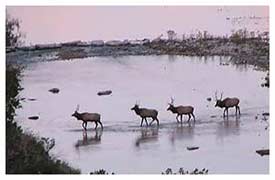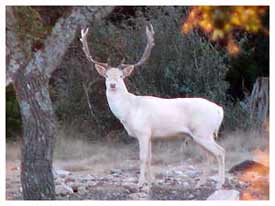Hunting Tips, Questions, Stories & Discussion
Focusing on managing Texas wildlife habitat and natural resources for native and exotic wild game species, for this and future generation of hunters and outdoor enthusiasts.Tuesday, January 20, 2009
What makes Escondido a unique Texas exotic hunting ranch?
 Besides the historical roots of the ranch, Escondido is a unique Texas exotic hunting ranch that has been in business since 1980. This means that the herds have been monitored and managed for optimum trophy animals as well as herd numbers and health for almost 30 years.
Besides the historical roots of the ranch, Escondido is a unique Texas exotic hunting ranch that has been in business since 1980. This means that the herds have been monitored and managed for optimum trophy animals as well as herd numbers and health for almost 30 years.While other Texas exotic hunting ranches may have over hunted their land area, the staff at Escondido has used a balanced management approach right from the start. Healthy stock is the norm at the ranch, leading to good production from does as well as ensuring a good hunt for those that want to hunt both exotics and native species. The added plus is the river running through the almost 2 square mile area, ensuring the best possible living conditions for a wide variety of native and non-native species.
What all comes with the cost of the hunt?
Every Texas exotic hunting ranch has different pricing options depending on the services that they offer. Escondido Ranch offers 15 different hunting options ranging from seasonal hunts for Whitetail does and bucks, bull Elk and Rio Grande Turkeys through to year round hunts for cow Elk, Aoudad sheep; Axis, Fallow and Sika deer, Russian boars and feral hogs as well as Blackbuck Antelope. Each species is individually priced for the hunt, with trophy bucks for Whitetail priced according to their B/C score.
In addition to the animal that they successfully hunt, each hunter also receives guided support for hunting including hunting tips and advice from a professional guide. The guides will also clean and quarter the animals and prepare them for packing into the hunter's coolers or ice chest for transport. Hunters can use the main lodge area and can also arrange for meals and accommodations through Escondido Ranch.
Where did the exotic species come from on Texas exotic hunting ranches?
All the exotic species have been imported from their native countries, most several generations ago. Some of the species were imported in the early 1900's and then spread into wild populations that were reclaimed and managed on Texas exotic hunting ranches, typically in the central and southern parts of the state. Usually the importing was done by avid hunters and landowners that noticed the resemblance and similarity between the climate of south central Texas and the specie's native range.
In some cases exotic species are still imported from other ranches and states to prevent inbreeding and keep the genetic balance within the herds. Some of the wild native species such as the Whitetail deer, Rio Grande Turkeys and the feral hogs may naturally move in and out of the ranch based on natural movement and seasonal patterns.
Animals on Texas exotic hunting ranches are allowed to live as wild and natural as possible, but they are also fed on a regular basis and treated for any health conditions that arise. The goal of staff is to maintain a healthy, viable but wild herd that provides hunters with a unique, challenging and very out of the ordinary hunting experience.
Labels: south texas hunting ranch, texas hillcountry deer hunting, texas hunting ranches, wild game hunting
Archives
December 2008 January 2009 February 2009 April 2009 May 2009 June 2009 July 2009 August 2009 September 2009 November 2009 December 2009 January 2010 February 2010 March 2010 April 2010
Subscribe to Posts [Atom]
